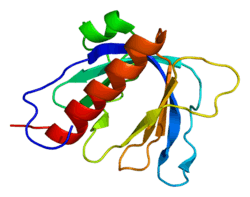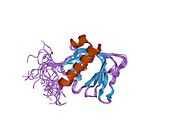SPTBN2
Spectrin beta chain, brain 2 is a protein that in humans is encoded by the SPTBN2 gene.[1][2][3]
Clinical significance
Mutations in this gene is associated with Spinocerebellar ataxia type 5.
Interactions
SPTBN2 has been shown to interact with:
References
- ↑ Stankewich MC, Tse WT, Peters LL, Ch'ng Y, John KM, Stabach PR et al. (Dec 1998). "A widely expressed βIII spectrin associated with Golgi and cytoplasmic vesicles". Proc Natl Acad Sci U S A 95 (24): 14158–63. doi:10.1073/pnas.95.24.14158. PMC 24343. PMID 9826670.
- ↑ Ikeda Y, Dick KA, Weatherspoon MR, Gincel D, Armbrust KR, Dalton JC et al. (January 2006). "Spectrin mutations cause spinocerebellar ataxia type 5". Nat Genet 38 (2): 184–90. doi:10.1038/ng1728. PMID 16429157.
- ↑ "Entrez Gene: SPTBN2 spectrin, beta, non-erythrocytic 2".
- ↑ 4.0 4.1 Mao B, Wu W, Li Y, Hoppe D, Stannek P, Glinka A et al. (May 2001). "LDL-receptor-related protein 6 is a receptor for Dickkopf proteins". Nature 411 (6835): 321–5. doi:10.1038/35077108. PMID 11357136.
- ↑ 5.0 5.1 Holleran EA, Ligon LA, Tokito M, Stankewich MC, Morrow JS, Holzbaur EL (September 2001). "beta III spectrin binds to the Arp1 subunit of dynactin". J. Biol. Chem. 276 (39): 36598–605. doi:10.1074/jbc.M104838200. PMID 11461920.
- ↑ Sakaguchi G, Orita S, Naito A, Maeda M, Igarashi H, Sasaki T et al. (July 1998). "A novel brain-specific isoform of beta spectrin: isolation and its interaction with Munc13". Biochem. Biophys. Res. Commun. 248 (3): 846–51. doi:10.1006/bbrc.1998.9067. PMID 9704016.
Further reading
- De Matteis MA, Morrow JS (2000). "Spectrin tethers and mesh in the biosynthetic pathway". J. Cell. Sci. 113 (13): 2331–43. PMID 10852813.
- Ranum LP, Schut LJ, Lundgren JK, Orr HT, Livingston DM (1995). "Spinocerebellar ataxia type 5 in a family descended from the grandparents of President Lincoln maps to chromosome 11". Nat. Genet. 8 (3): 280–4. doi:10.1038/ng1194-280. PMID 7874171.
- Nagase T, Ishikawa K, Nakajima D, Ohira M, Seki N, Miyajima N et al. (1997). "Prediction of the coding sequences of unidentified human genes. VII. The complete sequences of 100 new cDNA clones from brain which can code for large proteins in vitro". DNA Res. 4 (2): 141–50. doi:10.1093/dnares/4.2.141. PMID 9205841.
- Ohara O, Ohara R, Yamakawa H, Nakajima D, Nakayama M (1998). "Characterization of a new beta-spectrin gene which is predominantly expressed in brain". Brain Res. Mol. Brain Res. 57 (2): 181–92. doi:10.1016/S0169-328X(98)00068-0. PMID 9675416.
- Sakaguchi G, Orita S, Naito A, Maeda M, Igarashi H, Sasaki T et al. (1998). "A novel brain-specific isoform of beta spectrin: isolation and its interaction with Munc13". Biochem. Biophys. Res. Commun. 248 (3): 846–51. doi:10.1006/bbrc.1998.9067. PMID 9704016.
- Holleran EA, Ligon LA, Tokito M, Stankewich MC, Morrow JS, Holzbaur EL (2001). "beta III spectrin binds to the Arp1 subunit of dynactin". J. Biol. Chem. 276 (39): 36598–605. doi:10.1074/jbc.M104838200. PMID 11461920.
- Shoeman RL, Hartig R, Hauses C, Traub P (2003). "Organization of focal adhesion plaques is disrupted by action of the HIV-1 protease". Cell Biol. Int. 26 (6): 529–39. doi:10.1006/cbir.2002.0895. PMID 12119179.
- Nakayama M, Kikuno R, Ohara O (2003). "Protein–Protein Interactions Between Large Proteins: Two-Hybrid Screening Using a Functionally Classified Library Composed of Long cDNAs". Genome Res. 12 (11): 1773–84. doi:10.1101/gr.406902. PMC 187542. PMID 12421765.
- Bignone PA, Baines AJ (2003). "Spectrin alpha II and beta II isoforms interact with high affinity at the tetramerization site". Biochem. J. 374 (Pt 3): 613–24. doi:10.1042/BJ20030507. PMC 1223645. PMID 12820899.
- Olsen JV, Blagoev B, Gnad F, Macek B, Kumar C, Mortensen P et al. (2006). "Global, in vivo, and site-specific phosphorylation dynamics in signaling networks". Cell 127 (3): 635–48. doi:10.1016/j.cell.2006.09.026. PMID 17081983.
PDB gallery |
|---|
| | 1wjm: Solution structure of pleckstrin homology domain of human beta III spectrin. |
| 1wyq: Solution structure of the second CH domain of human spectrin beta chain, brain 2 |
|
|
|
|
|---|
| | Human | |
|---|
| | Nonhuman | |
|---|
| See also: cytoskeletal defects Index of cells |
|---|
| | Description |
- Structure
- Organelles
- peroxisome
- cytoskeleton
- centrosome
- epithelia
- cilia
- mitochondria
- Membranes
- Membrane transport
- ion channels
- vesicular transport
- solute carrier
- ABC transporters
- ATPase
- oxidoreduction-driven
|
|---|
| | Disease |
- Structural
- peroxisome
- cytoskeleton
- cilia
- mitochondria
- nucleus
- scleroprotein
- Membrane
- channelopathy
- solute carrier
- ATPase
- ABC transporters
- other
- extracellular ligands
- cell surface receptors
- intracellular signalling
- Vesicular transport
- Pore-forming toxins
|
|---|
|
|



